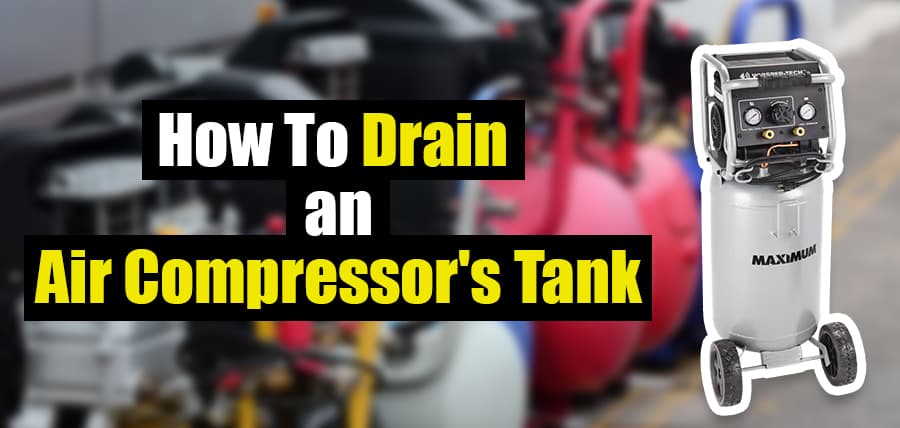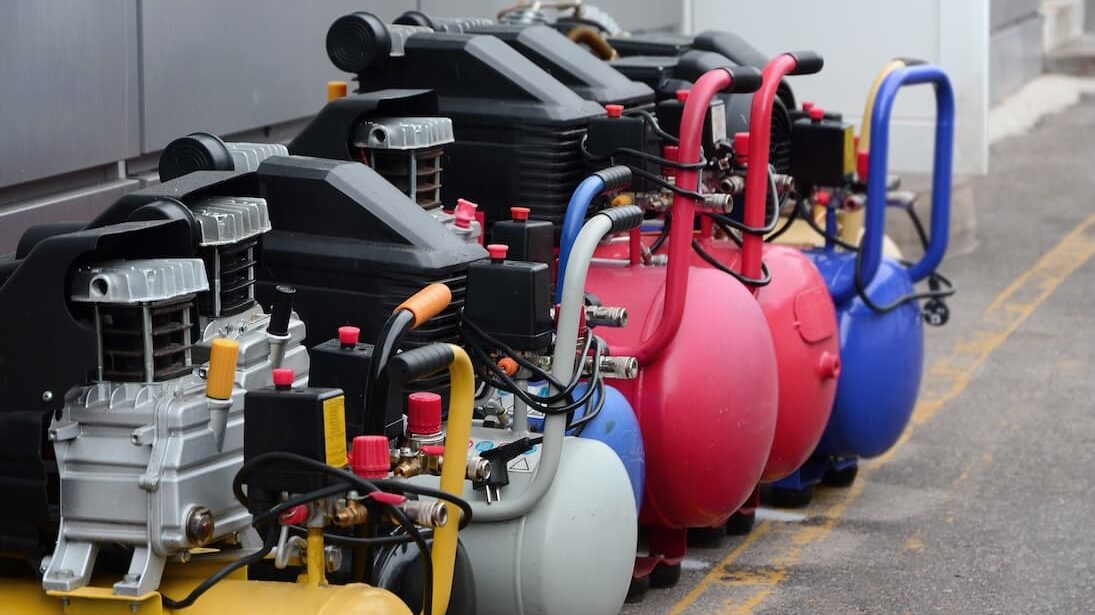Air compressors are costly tools that must be maintained.
One of the best ways to make sure this happens is making sure you drain your air compressor’s tank regularly, so it doesn’t corrode.
Unfortunately, I discovered that there is no comprehensive guide on how to do this, which is why I decided to create the following guide.
Let’s get right into it.
How to Drain an Air Compressor’s Tank
Whether you’re running an air impact wrench or another tool, an air compressor proves itself essential for the day to day of most workers.
Here’s the step by step guide on how to drain an air compressor’s tank and rest assured you’re checking every box to take care of your expensive air compressor.
- Turn the Air Compressor Off
- Open Safety Valve to Release Air Pressure
- Place Container Under Tank
- Locate Drain Valve and Open It
- Tilt Air Compressor to Remove Remaining Moisture
- Close Safety and Drain Valves
1. Turn the Air Compressor Off
The first step should be to completely turn off the air compressor.
This ensures that both you and your air compressor are safe to proceed with the remaining steps.
Also, remove any pneumatic tools currently hooked to the air compressor, so you’ve got plenty of space to work with.
2. Open Safety Valve and Release Pressure
The second step should be opening the safety valve. To do this you must first locate it, and then pull down its ring.
This should allow the tank’s air pressure to be released, allowing you to complete the following steps safely.
When the air pressure inside the tank reaches 10 PSI, you can stop releasing air pressure and proceed with the remaining steps.
Wearing safety glasses is mandatory here; otherwise, you risk having debris shot into your eyes, which could result in serious injuries.
3. Place Container Under The Tank
When you finish the next step, all of the moisture in the air tank will be released.
That’s why I always put a large container right under the drain valve so that all the liquids that come out of the air tank have somewhere to go.
4. Locate Drain Valve and Open It
Now comes the exciting part.
Drain valves are standard on all air compressors. These valves are in charge of releasing the water and moisture contained within the tank so that your air compressor’s tank does not corrode.
The majority of drain valves are found directly beneath the air compressor’s tank. You can identify yours by reading the manual or simply inspecting your air compressor.
Once you’ve found it, you must fully open it. This will allow the water to exit the air tank and hopefully fall into your container.
Allow the drain valve to remain open until all water has been removed. Then, close it.
5. Tilt Air Compressor and Remove Remaining Moisture
Even after opening the drain valve and letting all of the water out, there is usually some water left.
This is why I recommend tilting the air compressor. That way, you’ll be assisting the water in finding the path of least resistance, which is the drain valve.
This should be sufficient to remove all of the water from the air compressor’s tank.
6. Close Drain Valve
After completing steps 4 and 5, you will be certain that all of the water has been removed from the air compressor’s tank.
You can now go about your day knowing that your air compressor will not be corroded anytime soon because all of the moisture and water has been removed from the tank.
Best Portable Air Compressor
Makita MAC2400 2.5 HP Big Bore™ Air Compressor
Features
- Airflow rates: 4.2 CFM at 90 PSI with a Max. Pressure 130 psi
- Tank size: 4.2 gallons
- Construction: Role-cage construction
This Makita MAC2400 air compressor has impressive features that lead me to believe it is one of the best available.
First, its 2.5HP 4-pole motor produces 4.2 CFM at 90 PSI, allowing users to run most pneumatic tools with ease.
Furthermore, the cast iron pump with Big Bore cylinder ensures that the air tank will only take a few seconds to refill, which is key for productivity.
I know it’s heavy, weighing in at 80 pounds. However, its portable role-cage construction and peacock design make up for this drawback.
Finally, it has an industrial air filter, which is necessary to keep the air compressor free of dust and debris so that it can last longer.
Pros
- Cast iron pump with Big Bore cylinder and piston allows for fast air refill
- 2.5 HP 4-Pole motor produces 4.2 CFM at 90 PSI to run your most power-hungry pneumatic tools (e.g. air impact wrench)
- Role-cage construction provides durability
- Industrial air filter for increased efficiency
- It only makes 79 decibels of noise
- Portable peacock design
Cons
- Bit heavy, weighing 80 pounds
Frequently Asked Questions
Did I answered all the questions you’ve got regarding cleaning an air compressor’s tank?
Probably not, which is why I made the following part answering the most frequent questions regarding that topic.
Why Drain Water From an Air Compressor Tank?
We all know that water accumulates inside an air compressor’s tank as a result of condensed humidity and condensed water vapor inside the compressed air.
But why do we want to get rid of this water?
Metal and water don’t get along. When water remains on a metallic surface for an extended period of time, it corrodes it. Because an air compressor’s tank must be completely sealed, this could be a serious problem.
Not only that, but a corroded air tank may explode due to its inability to hold the generated air pressure.
How do Drain Valves Work?
Drain valves are designed to release water accumulated as a result of condensation of water vapor inside compressed air or by sudden temperature changes.
The drain valve is normally located at the bottom of the air compressor’s tank and must be turned counter-clockwise to be completely opened.
The water will flow out of the air tank once this valve is opened. Once all of the water has been removed, turn the drain valve clockwise to close it and prevent air pressure loss when the air compressor is turned on.
How Often Should You Drain Your Air Compressor?
Water corrodes metal surfaces in about a week, which is why you should drain your air compressor at least once a week.
However, I believe that draining the air tank after each use is preferable because it ensures that water will never corrode it. This is especially true if you live in a humid area.
What Happens when the Air Compressor is Not Drained?
Water and metal surfaces do not get along, as I previously stated.
Water has a high concentration of dissolved oxygen, which reacts with the iron in the metal (a process known as oxidation) and causes it to break down faster.
In addition, water that is highly acidic or alkaline which speeds up this process.
So, by not draining the air compressor of water, you allow corrosion to occur, which could jeopardize not only the air pressure that the tank can hold, but also cause the air tank to explode.


